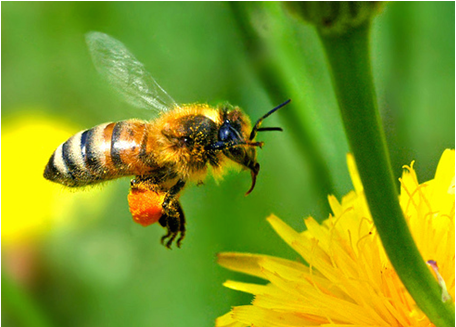 Finally enough attention has been brought to the demise of the honey bee population that something is being done about it. It’s not just the honey bee that is in jeopardy, but butterflies, moths, and other pollinators. With $20 billion of crop value at stake in the US alone, the good news has brought a collective sigh of relief to farmers, and the many offshoots of the food industry.
Finally enough attention has been brought to the demise of the honey bee population that something is being done about it. It’s not just the honey bee that is in jeopardy, but butterflies, moths, and other pollinators. With $20 billion of crop value at stake in the US alone, the good news has brought a collective sigh of relief to farmers, and the many offshoots of the food industry.
The food service business, grocery outlets, restaurants, and large and small scale caterers all count on the natural cycles within Nature’s food chain to bring the essentials to their trade are feeling hopeful. The pending disaster brought to light a few years ago of not having crops pollinated put all of our food in jeopardy.
The humble, but royal little honey bee is one of the most important elements in the production of healthy, sustainable agriculture that we have. Although the bee is the first to come to mind when thinking of pollinating; moths, birds, wasps, butterflies, ants, lizards and even bats are other big players in the game.
First reports of declining bee populations were submitted in 2006. A condition known as CCD, colony collapse disorder left the hives without the necessary number of worker bees. The Queen and the brood were left in a sense to fend for themselves. The result of instability meant the sure demise of the hive. CCD cannot always be blamed on human intervention, but is also an outcome of natural engagements like the bee mite or harsh winter weather conditions. These account for hive deaths every year and a bee keeper expects a percentage of loss from these conditions. However . . .
Bees were dying by the millions and it took a while to discover why. In this authors opinion, the causes would have been acknowledged sooner if there was less push back by the big agri-chemical concerns like Monsanto. What has been discovered is the pesticides used on crops to kill predatory insects were also killing and sterilizing the pollinators.
One of the most significant steps taken to protect pollinators has been the labeling of neonicotinoid pesticides – which are the main culprits that point to bee deaths. Usage of these harsh chemicals is now mandated and they are not to be applied to crops until the flowering has completed its cycle. Since these pesticides cannot be used at certain times of the growing stage therefore the pollinators are not directly affected.
Largely influenced from behind the scenes by Michelle Obama, in June of 2014 a Pollinator Health Task Force was established. Teaming with the USDA and EPA the Pollinator Health Task Force was founded to promote the health of honey bees and other pollinators.
Since the threat was first discovered a fair amount of attention has been given to solving the problems. Fortunately the problem was seen for the disaster it could be. Things never move fast enough in the wheels of bureaucracy, but avoiding a catastrophe of this magnitude became and still is a priority.
Last week Congress signed into law reserving 7 million acres of US land to be designated for the protection of the honey bee. These acres will be pesticide free. In addition to growing a cleaner environment these acres will be planted with honey bee and pollinator vegetation and specific plants that support the little buggers.
There’s always more to be done and it’s important to keep our voices alive and heard on this subject. As beneficiaries and custodians of the planet we have a responsibility to do our best to protect and serve our most valuable assets in Mother Nature.